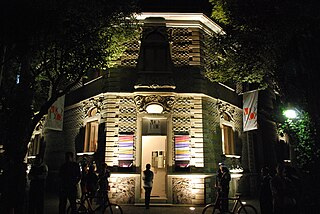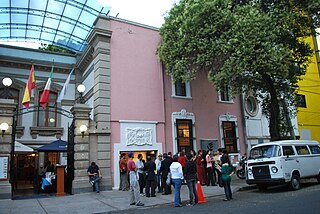 W
WColonia Roma, also called La Roma or simply, Roma, is a district located in the Cuauhtémoc borough of Mexico City just west of the city's historic center, and in fact is no longer a single colonia (neighbourhood) but now two officially defined ones, Roma Norte and Roma Sur, divided by Coahuila street.
 W
WAvenida Álvaro Obregón is an avenue in the Roma district of Mexico City, divided by a park median along which fountains are located with characters from Roman and Greek mythology.
 W
WThe Casa Lamm Cultural Center is the best known landmark in Colonia Roma. It was a house built in the early 20th century when Colonia Roma was a new neighborhood for the wealthy leaving the historic center of Mexico City. In the 1990s, the house was restored to open as a cultural center in 1994, with the aim of making the area a center for the visual arts. Today, it hosts numerous exhibits as well as offering classes, even degrees, in art and literature.
 W
WThe Casa Lamm Cultural Center is the best known landmark in Colonia Roma. It was a house built in the early 20th century when Colonia Roma was a new neighborhood for the wealthy leaving the historic center of Mexico City. In the 1990s, the house was restored to open as a cultural center in 1994, with the aim of making the area a center for the visual arts. Today, it hosts numerous exhibits as well as offering classes, even degrees, in art and literature.
 W
WThe Centro Urbano Benito Juárez, more commonly called the Multifamiliar Juárez, was a large apartment complex built on the southeast section of Colonia Roma, Mexico City in the late 1940s and early 1950s. It was one of several projects of this type by architect Mario Pani, designed to be semi-autonomous and incorporate as much outdoors space as possible. It also featured one of the largest mural works of the 20th century by artist Carlos Mérida. Most of the complex, and the mural work with it, were destroyed by the 1985 Mexico City earthquake and the demolition of many of the damaged buildings. Only a few of the original buildings still remain. Despite this, the Cuauhtémoc borough in which it is located still lists it as a separate colonia or neighborhood.
 W
WEstadio Nacional was a multi-use stadium in the Colonia Roma Sur neighborhood of Mexico City, Mexico. It was built in 1923; the architect was José Villagrán García. It was mostly used for football and athletics and was used as the main stadium for the 1926 Central American and Caribbean Games. It was replaced by the Estadio Olímpico Universitario in the Ciudad Universitaria, in the south of the city, in 1949, and the site was used for multifamily housing which was demolished after damage from the 1985 Mexico City earthquake. Today the site is a park, the Jardín Ramón López Velarde. The capacity of the stadium was 30,000 spectators.
 W
WThe Fountain of Cybele in Mexico City is a bronze replica of the fountain located in the Plaza de Cibeles in Madrid that was built during the reign of Charles III by architect Ventura Rodríguez between 1777 and 1792. The Mexican version is located at a traffic circle in Plaza Villa de Madrid, where Oaxaca, Durango, Medellín and El Oro streets converge in Colonia Roma.
 W
WGarros Galería or Garros Gallery is located in Colonia Roma in Mexico City. It is the only art gallery and museum dedicated to cats in Mexico.
 W
WThis article covers the history of the Colonia Roma neighborhood of Mexico City.
 W
WInsurgentes is a station on the Line 1 of Mexico City Metro. It is located within the Glorieta de los Insurgentes at the intersection of Avenida de los Insurgentes and Avenida Chapultepec in Mexico City's Cuauhtémoc borough, close to the Zona Rosa shopping and entertainment district and the Colonia Roma, two of the most iconic neighborhoods in the city. In 2019, the station had an average ridership of 65,134 passengers per day, making it the 12th busiest station in the network.
 W
WJardín Edith Sánchez Ramírez is a pocket park in Colonia Roma, Mexico City. It is located in the triangle formed between calles Yucatán, San Luis Potosí and Tonalá. It is named for Edith Sánchez Ramírez, who was an activist who helped refugees of the 1985 Mexico City earthquake obtain housing. In 2012 the park was in disrepair but it was renovated in 2014, financed by American Eagle Outfitters.
 W
WLa Romita is a small neighborhood located in the Colonia Roma section of Mexico City. The area began as an independent pre Hispanic village called Aztacalco, later renamed Romita. When the area around the village was redeveloped into housing for the wealthy, the village resisted and remained separate socially although officially part of Colonia Roma. During the 20th century the area had a reputation for being dangerous as it residents were relatively poor. Today, the area is no longer poor or dangerous, but its streets are narrower than the rest of Colonia Roma and its residents still consider themselves distinct.
 W
WThe Mercado de Medellín, also Mercado Medellín and officially Mercado Melchor Ocampo is a public market located on Medellín street in Colonia Roma Sur neighborhood of Mexico City. It is known as the market in the city where one can find produce and goods from other countries in Latin America such as Colombia and Cuba, whose flags hang from many stalls, as well as from Yucatán in Mexico. It has been nicknamed "La Pequeña Habana", and there are over 500 stalls in total.
 W
WMercado Roma is a public market in the format of a gourmet food hall located on Querétaro street in the Colonia Roma Norte neighborhood of Mexico City. The market stalls offer organic and other food products for sale; stands and counters where visitors can eat a variety of cuisines. Some of the stands are from restaurants or shops well known outside the market, such as Que Bo! chocolates, Azul Mexican food and Butcher's hamburgers.
 W
WThe Museo del Objeto del Objeto, or MODO, is a museum in Mexico City and the first museum in Mexico dedicated to design and communications. It was opened in 2010 based on a collection of commercial packaging, advertising, graphic arts, common devices and many other objects dating back to 1810 collected by Bruno Newman over more than forty years. The museum is dedicated to the preservation of its collection of more than 30,000 items from two centuries and to the research in the history of design and communications.
 W
WPlaza Villa de Madrid is a traffic circle in Colonia Roma, Mexico City, where Oaxaca, Durango, Medellín and El Oro streets converge. The Fuente de Cibeles is installed in the center.
 W
WSalón de la Plástica Mexicana is an institution dedicated to the promotion of Mexican contemporary art. It was established in 1949 to expand the Mexican art market. Its first location was in historic center of the city but today it mostly operates out of a building in Colonia Roma. The institution is run by a membership of almost four hundred recognized artists and holds multiple exhibitions each year. Although it operates autonomously, it is part of the Instituto Nacional de Bellas Artes y Literatura.
 W
WThe trolleybuses of Roma Condesa are permanently parked trolleybuses in the Roma and Condesa neighborhoods of Mexico City that were used for art and other projects. Most were Japanese buses that were donated to Servicio de Transportes Eléctricos by the Kansai Electric Power Company in Japan in 1994, for possible operation, which never came to fruition, and in 2000 they were repurposed by Cuauhtémoc borough in a programme to create educational centers. However, the Trolebuses Educativos programme lasted only a few months. Some of the trolleybuses remained in use as simple reading rooms, but others sat abandoned until 2005, when the “Galería Trolebús” was begun to promote non-traditional art projects. The gallery ceased operations in 2009 due to financial problems, but the buses continued to be used for art projects until about 2014. Two other trolleybuses involved were not Japanese vehicles.